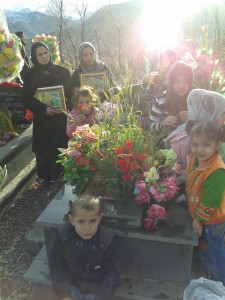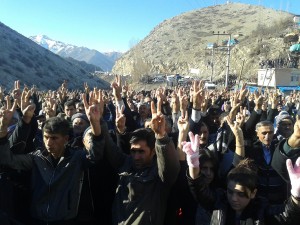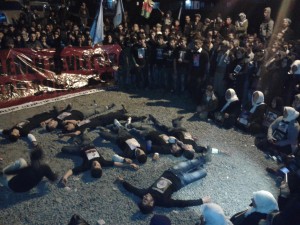(written for an English language site, sorry, no time to translate to Dutch)
It is not just the families of the victims of the Uludere massacre who still feel the pain of their loss. The whole village is affected by the bombings, which occurred just over a year ago, on December 28, 2011. But the pain of the entire community can be seen in each of their stories.
‘It has been a year of tears and of thoughts’, says Pakize Kaplan (29), who lost her husband Osman (32) in the Uludere massacre. She was left behind with three daughters and two sons, now aged between 6 and 12.
Pakize is not very much on the foreground, compared to some of the mothers of victims of the massacre. She mourns mostly in private. What has she changed over the past year? Pakize: ‘We don’t know what exactly happened, and maybe we will never find out. But God knows everything, and that gives me some comfort’.

Pakize Kaplan, with the light headscarf, next to the grave of her husband Osman. (pic by me, click to enlarge)
Pakize takes the picture of her husband with her when she heads for the commemoration on December 28, 2012. This is what all mothers, wives and grandmothers of the deceased do when there is a meeting or ceremony concerning last years event. The fact that there is a routine to mourning lost family is as horrifying as anything. But this way, they give the 34 lost human lives a face and make sure they are not forgotten.
At the graveyard, where a few thousand people come together to commemorate and where several prominent Kurdish politicians and activists are present, all 34 names are read. After every name, the crowd shouts out “He is here!”
That the Turkish government hasn’t opened up about the details of the massacre hinders the healing of the villages where most deceased where coming from: Gülyazi (Bujeh in Kurdish) and Ortasu (Roboski in Kurdish). By implicating that the villagers who were smuggling petrol that evening last year were linked to the PKK, the government opens the wounds again and again.
The anger about that and the pain of the big loss, affects the whole community. Several young men no longer attend school because they couldn’t concentrate on their lessons anymore. One of them, 17 year old “S.”, says: “Our morale is totally broken. Now we try to work. Yes, we also smuggle. There is not much other work here. I’m not really scared to go. We never though that anything like what happened last year could ever happen. It will not easily happen again.”
For young women the situation is difficult too. Semire Encü, who lost her 13 year old brother, has just turned 18. She is not attending school anymore, and when asked about any wedding plans, she says: ‘I will never get married, never. The boys are dead.’

People make V-signs during two minutes of silence during the commemoration of the Uludere/Roboski massacre, 28 December 2012. (pic by me, click to enlarge)
The community – as well as several villages in the surroundings – haven’t celebrated any weddings since the bombing. The huge Kurdish weddings with up to to one hundred people dancing a traditional <em>govend </em>on a green field between the mountains, are over. Nobody feels like celebrating anything, and nobody in the village can tell when they will resume again. The women all still wear black as they have for the past year, as their mourning continues and the mystery around the bombing remains.
Poet Abdurrahman Adiyan, from the western Turkish city of Bursa, visited Gülyazi and Ortasu several times in the last year. He wrote a poem about the massacre right after it happened, but he felt he needed to do more for the community. He ended up visiting all the families of the victims, talked to them about the one they lost and made a personal poem or every family.
“I hope poetry can help people in their healing,” Adiyan says. “At some point, the bombing must be left to history, and the memory must be kept alive. Art is a good way of doing that’”
Adiyan visited all the families again during the Feast of Sacrifice in October, and read the poems to them. The families requested that he do so. Adiyan: “I hope the families can picture their loved one before their eyes while hearing and reading the poetry.” Narin Ant (21), who lost her 19 year old brother Adem, gets tears in her eyes when she hears the poem again. “I do picture him,” she says.

Students fall on the ground one by one to symbolize the Uludere/Roboski massacre. (pic by me, click to enlarge)
At the same time, Adiyan realizes the village is a long way from leaving the event to history. “The mothers are still in such deep sorrow and so many questions remain, that it is too early. Still, I hope I have made a contribution. I chose poetry because it is lasting. It can help people in the future too.” A book with all the poems was published on the first anniversary of the massacre, called <em>The Border Stone with Number 15</em>, the border stone where the bombing took place.
The strength of art in the face of sorrow was also shown at the evening of December 28. A group of Kurdish students walked down from the graveyard to the place where the commemoration was held, holding torches and shouting slogans. Then they gave a heart breaking performance, watched by the community, including the women who lost their sons, husbands, grandchildren.
All the 34 names were read out loud. After every name, one student stepped forward, said, “I was bombed to death,” and fell down on the floor. They were wearing T-shirts with the pictures and names of the deceased. Meanwhile, the crying of the mothers, other villagers and many visitors could be heard. Maybe art, and the strong unity and solidarity of the community, can help the people heal.


Recente reacties